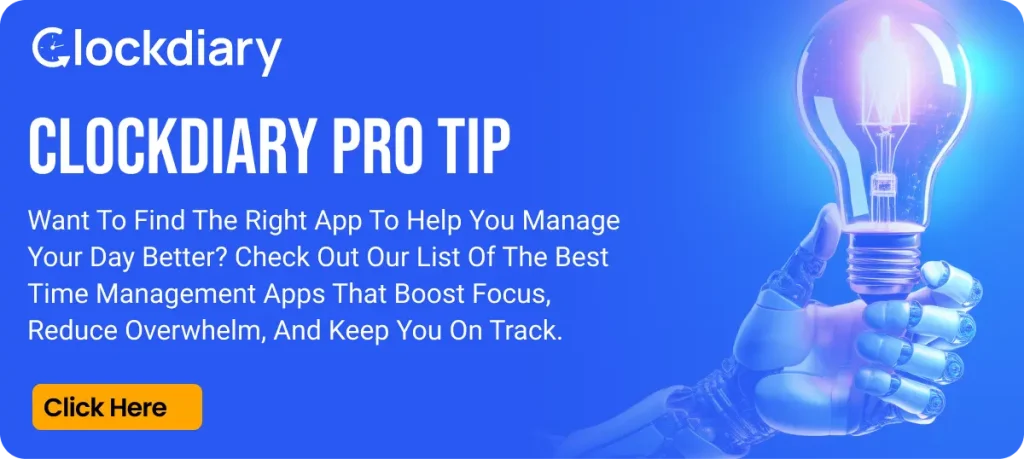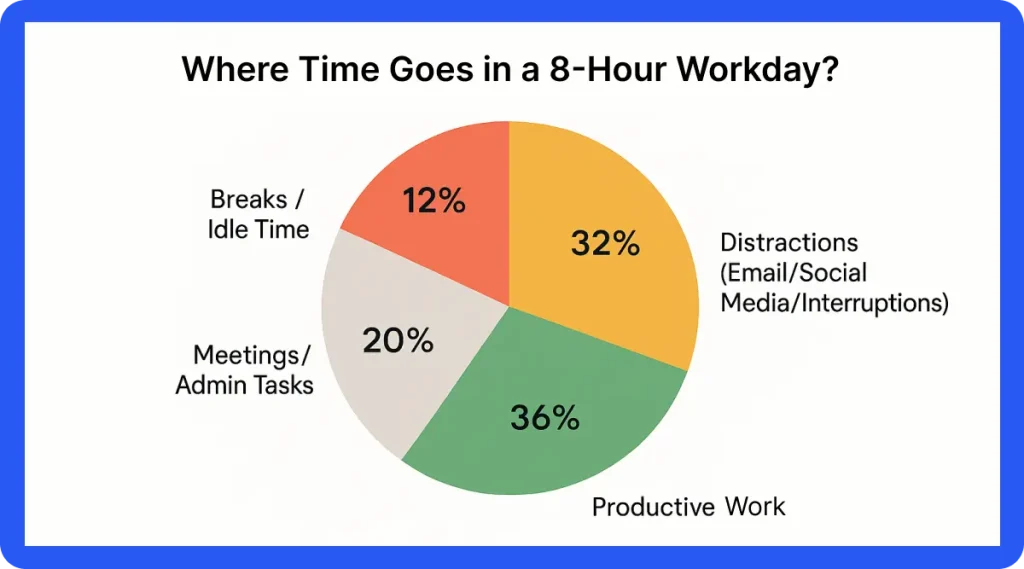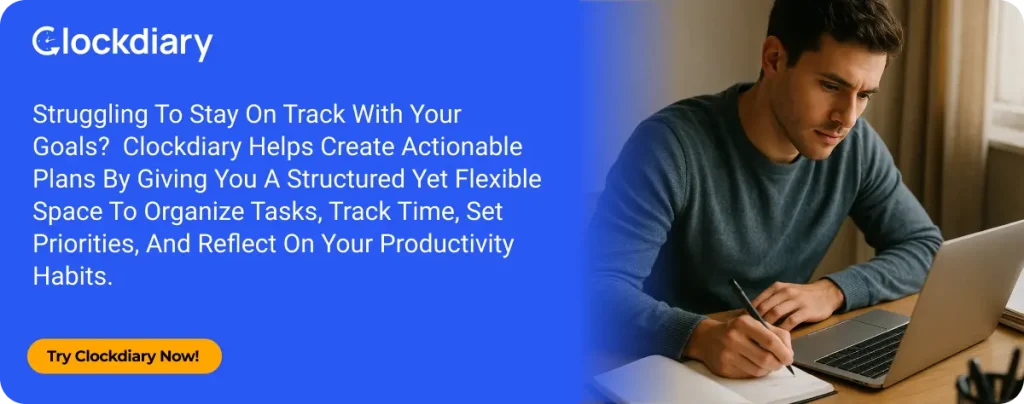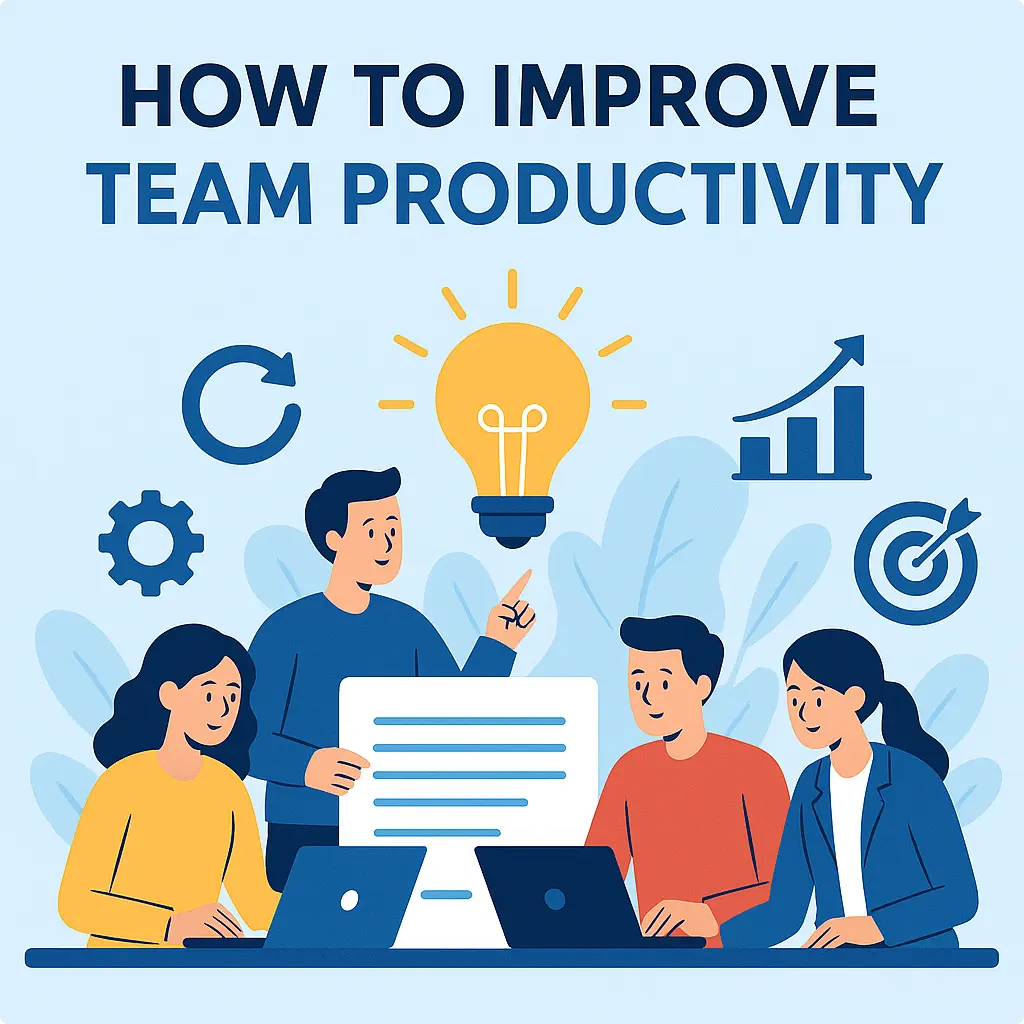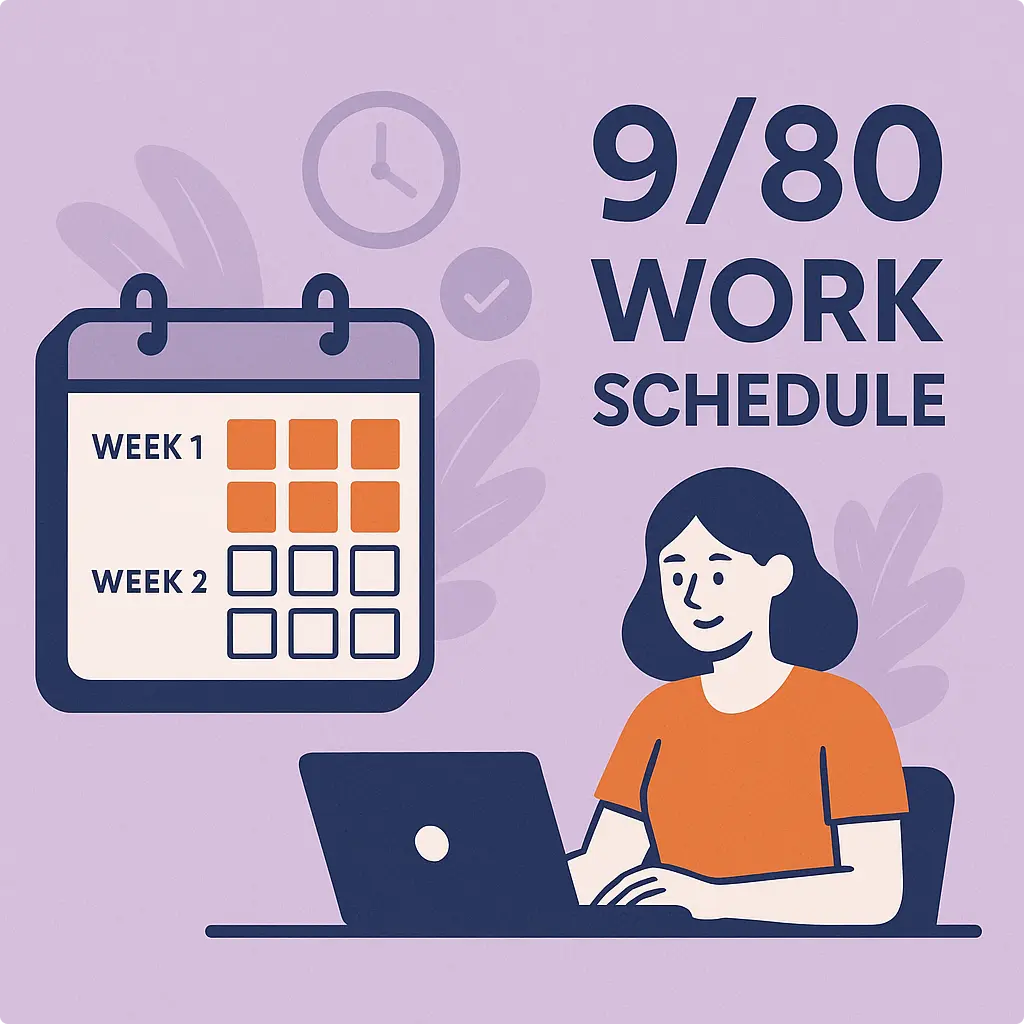Have you ever wondered why, despite your growing to-do list, you are not making meaningful progress? Recent data reveals that the average office worker spends only 2 hours and 53 minutes being productive, leaving nearly 5 hours unproductive each workday. This single statistic clearly highlights the urgent need to learn how to be more productive.
Whether you are an employee, student, or just an individual thinking about how to be productive in life, staying focused and making real progress can feel like an uphill battle. But productivity is not just about doing more but about doing what matters most, efficiently and with intention.
In this blog, we will break down 17+ proven tips on how to be more productive, productivity planning, how to measure productivity, and tools to improve productivity.
What is Productivity?
Productivity is the measure of how efficiently a person, team, or system converts inputs, such as time, energy, or resources, into meaningful outputs. In a personal or workplace context, productivity reflects how effectively tasks are completed within a given timeframe to achieve specific goals.
| To put it in a mathematical format, the productivity meaning can be expressed as: Output / Input = Productivity |
High productivity means getting more done with less effort or time, without sacrificing quality.
NOTE: It is important to note that productivity is not about being busy, but about creating value.
17+ Proven Productivity Tips
If you are someone looking to learn how to be more productive and make the most of your time, mastering the right productivity tips is essential. These are the same techniques that have helped countless people direct their energy toward meaningful results.
Here are 17+ proven productivity tips that will answer your question on “how to boost productivity?”, help you stay focused, overcome procrastination, and significantly improve your output.
1. Use the 2-Minute Rule
David Allen, a popular American author, popularized this 2-minute rule in his book “Getting Things Done”. This helps people learn how to be more productive through a simple rule that insists you complete any task you can finish in two minutes (or less) immediately, rather than postponing it.
How to Follow?
Scan incoming tasks or messages and ask yourself, “Can this be done in under two minutes?” If yes, then just do it. Don’t add it to your to-do list or schedule it later.
What are the Benefits?
- Cuts mental clutter by eliminating tiny to-dos before they pile up
- Builds momentum, thanks to that satisfying “checkmark” effect
- Reduces procrastination and frees brain power for larger tasks
Examples:
Replying to a short email, filing one sheet of paper, or scheduling a follow‑up call in the calendar can improve workplace efficiency and allow you to spend more time on larger tasks.
2. Avoid Multitasking
Multitasking is the act of shifting attention rapidly between tasks. According to the American Psychological Association, multitasking is proven to slow down productivity, increase mistakes, reduce meaningfulness, and even lower your IQ. Multitasking is one of the things people who want to know how to be more productive should never do.
| As Michael Harris, a recipient of the Governor General’s Literary Award, puts it:“When we think we’re multitasking, we’re actually multiswitching…we are simply giving ourselves extra work.” |
How to Follow?
Work on one task at a time. Close extra tabs, disable notifications, and tackle tasks sequentially. Use dedicated, focused intervals on a single task before switching.
What are the Benefits?
- Improves concentration and output quality
- Cuts down on errors and cognitive overload
- Reduces stress and mental fatigue from constant switching
Examples:
If you are an employee learning how to be more productive, you can implement this tip by instead of checking email while writing a report, closing email, and focusing fully on writing the report. Then you can switch and write your email.
3. Take Short Breaks
The National Library of Medicine states in a research study that taking short or “microbreaks” between tasks helps in preventing accumulated strain on the brain. So, it is important that you take scheduled pauses to recharge yourself and be productive, rather than working long-term.
How to Follow?
Set a timer for completing a particular work, and once completed, take a short 5 to 10-minute break. Or, you can take 30-second to a few-minute “microbreaks” to reduce feeling mentally or physically fatigued.
What are the Benefits?
- Boosts focus and improves productivity at work
- Prevents burnout and decision fatigue
- Enhances creativity and time spent on tasks as clarity returns after a short rest
Examples:
Stand and stretch every hour. Try walking outside for fresh air during lunch. Focus on relaxation and engage in deep breathing exercises. Most importantly, avoid screen time to relax your eyes and mind.
4. Make a To-do List
One of the best tips to be more productive is creating a to-do list. The psychology of a to-do list lies in its ability to ease mental overload. Since your attention span is limited and your mind can only hold so much at once, a to-do list helps lighten the mental load by organizing your tasks externally.
By transferring tasks from your mind to paper (or digital form), you relieve your brain from juggling everything and free up mental space to focus and perform more effectively.
How to Follow?
Being someone who wants to know how to be more productive, you can start by writing your list by hand or with a digital planner that you review and refresh daily. Prioritize highest‑impact tasks first.
What are the Benefits?:
- Frees up mental load so you don’t have to remember everything
- Clarifies priorities and next steps
- Creates a satisfying routine and visible progress
Examples:
At the end of your day, jot tomorrow’s tasks. Keep a running “now, soon, later” list for better time and project management. Handwriting helps embed tasks more deeply into your brain.
5. Set Small Goals for Big Results
If you want to know how to be more productive, one of the best methods is setting small and achievable goals. This helps you achieve goals faster, feel more productive, give a sense of progress, and motivate you towards finishing more.
How to Follow?
Identify your main goal (e.g., write a report). Then define small milestones: outline, first paragraph, check references. Focus on one small objective at a time.
What are the Benefits?
- Reduces overwhelm and procrastination
- Builds confidence gradually with frequent accomplishments
- Aligns with the “One Thing” principle: focus on one helpful thing at a time
Examples:
Break the task into small goals like researching for 20 minutes, drafting one section at a time, and editing after a short break to stay focused and increase productivity hours.
6. Gamify Your Tasks
The next on our list on how to be more productive is gamifying your tasks. Gamification means applying game-like elements, such as gifts, to turn routine work into a motivating game. According to recent studies, 89% of employees say a gamified task at work makes them more competitive.
How to Follow?
Pick a task list, assign points for completing each item. Set daily or weekly point targets. Reward yourself when you hit milestones, whether that’s a break, a treat, or a fun activity.
What are the Benefits?
- Makes work feel fun and engaging
- Creates a feedback loop that reinforces consistency
- Helps build daily habits and momentum
Example:
Let’s say you have a busy workday ahead. To gamify it, assign small rewards to specific tasks. For example, once you finish writing your report’s first draft, treat yourself to your favorite snack.
7. The 3-3-3 Rule for Productivity
Productivity can be improved by the 3-3-3 Rule, a simple mental reset strategy that was popularized by Oliver Burkeman, the author of Four Thousand Weeks. Named after him as the Burkeman’s 3-3-3 Rule, it is a tip that has helped thousands learn how to be more productive during their work or study.
How to Follow:
Start your day by dividing your time and energy using the 3-3-3 framework:
- Spend 3 hours on your most important tasks
- Tackle 3 smaller tasks you’ve been avoiding
- Do 3 maintenance activities
What are the Benefits:
- Centers your attention and clears mental clutter
- Reduces anxiety and cognitive overload
- Reboots focus by anchoring you in the present moment
Examples:
If you are a project manager learning how to be more productive, you can start by spending 3 hours on high-priority project planning. Then, you can complete 3 smaller tasks like team follow-ups, and handle 3 maintenance activities such as organizing your inbox, updating your task board, and reviewing your calendar to stay productive.
8. Steve Jobs’ “10-minute Rule”
Steve Jobs reportedly used a rule on how to become more productive: if you have struggled with a difficult problem for around 10 minutes without progress, stand up and take a walk.
While to most this might seem like procrastination, neuroscience supports this method, stating that movement often stimulates new ideas and problem-solving.
How to Follow?
Work steadily on a problem. If, after about ten minutes, you still feel stuck, pause and go for a walk outdoors or around the house. Use that time to let your mind shift. Return to the problem after 10 to 15 minutes.
What are the Benefits?
- Triggers fresh mental pathways and creativity
- Lowers stress and mental frustration
- Helps break rigid thinking loops for better insight
Examples:
Stuck on a tricky spreadsheet or paragraph? Step outside and take a short walk. Steve Jobs’ biographer Isaacson noted that many great Apple decisions happened during walking conversations.
9. Pareto Principle (80/20 Rule)
The Pareto Principle, also known as the 80/20 rule, states that roughly 80% of outcomes come from 20% of efforts. For those who want to know how to improve productivity, this is one of the best strategies to follow.
Named after Vilfredo Pareto, an Italian economist, the 80/20 rule reveals that a small portion of your efforts often leads to the majority of your results, showing that focusing on key tasks can drive the biggest impact.
How to Follow?
Identify your top 20 % tasks that yield the most value. Prioritize those first. Minimize or delegate low-impact activities. Regularly review your task list and ask: “Is this really moving the needle?”
What are the Benefits?
- Maximizes ROI of your time and effort
- Clarifies priorities and reduces decision fatigue
- Encourages strategic focus over busywork
Examples:
If out of 10 tasks, three generate the most results, focus on those. In business, spend more time on client meetings than on administrative email. In studying, focus on core concepts over trivia details.
10. 3 P’s of Productivity: Plan, Prioritize, Perform
The 3 P’s of Productivity: Plan, Prioritize, Perform represent a streamlined work approach, such as planning your tasks, prioritizing what matters most for proper time management. This is one of the fastest way to work effectively with a focused effort.
How to Follow?
- Plan: At day’s start or prior evening, list tasks.
- Prioritize: Rank by urgency or impact
- Perform: Start the most important item and work without interruption until complete before moving on.
What are the Benefits?
- Provides clarity and structure to your workflow
- Helps avoid feeling overwhelmed by filtering what’s critical
- Encourages deep, uninterrupted focus on essential tasks
Examples:
Learning how to be more productive starts with focusing on great work, not just busy activity. Each morning: plan your day’s to-dos, pick the top two critical tasks (A), the next few (B), and the less important (C). Begin working on A tasks one by one.
